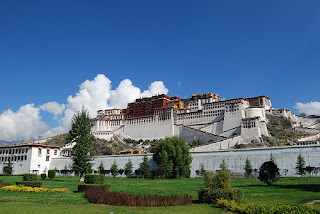Chapter Two
Potala Palace-Wonder Your Wonders
High on Mount Moburi, in the west of Lhasa, stands the world famous Potala Palace. This amazing palace has the honor of being the highest ancient palace in the world, with its highest point reaching to more than 3,700 meters (12,000 feet) above sea level. A UNESCO World Heritage Site, the Potala Palace was built during the Tang Dynasty of the 7th century BCE during the reign of King Songtsan Gampo of Tibet and is still considered a sacred site for many Tibetans.
Description of Potala
 |
| Potala Palace |
Built as a present from King Songtsan Gampo to his bride to be, this thirteen-story palace has over 1,000 rooms and covers over 130,000 square meters. The stone walls measure 3 meters thick on average. Housed within this amazing stone and wood structure are articles and artifacts from Tibetan history, religion, and culture. Statues of Buddha, murals, antiques that are centuries’ old, and incredible works of art grace every area of this mountain top palace.
Design Style of Potala
The general structure of the Potala Palace is broken into two parts; the Red Palace and the White Palace.
The Red Palace is the higher of the two sections and is made up of several chapels. Used as a house of prayer by the Dalai Lama, this part of the Potala Palace was dedicated to the study of Buddhism and the advancement of the religion. Housed within the Red Palace are several mausoleums of previous Dalai Lamas.
Each mausoleum is built with stateliness and honor in mind. The mausoleum of the fifth Dalai Lama, located in the western part of the palace stands five stories high, is overlaid with goald, diamonds, pearls, and many other precious gems, and expresses the high honor the people had for this Buddhist saint.
 |
| Design style of Potala |
The White palace is home to the current and successive Dalai Lamas and their pupils. Also located here are the offices of the Tibetan government, governmental assembly halls, and other official offices.
The original White palace was destroyed during the ninth century, near the end of the Tubo Era. The fifth Dalai Lama ensured its refurbishment during the late seventeenth century and, therefore, this structure pays homage to him in greater measure than previous Dalai Lamas or those that would follow. After the Dalai Lama built Norbulingka Park and named it the summer residence for the Dalai Lama, the White Palace became known as the winter estate of this saint of Buddhism.
Inside of Potala
The Potala Palace is filled with elaborate works of art and murals that tell many stories of the Dalai Lama, the history of the Tibetan people, and depict different customs and traditions held dear in this beautiful part of the world.
 |
| Mural |
One area of particular importance are the wall frescoes that depict the life and works of the fifth Dalai Lama, for whom the current structure owes its thanks. Also included inside the Potala palaces are other precious works of art, including ornate statues, sculptures, and Tibetan paintings.
Of all the ornate decorations located within these sacred walls, visitors should take time to visit the topmost hall. Called Sasong Langjie, this hall was built in 1679 and contains a portrait of the Qing Emperor Qianlong. An inscription on this portrait reads “A long, long life to the present emperor” is written in the languages of Han, Manchu, Mongol, and Tibetan. It is here that Dalai Lamas have come to pay homage every Tibetan New Year's Day for centuries as they pray for guidance and direction for the Tibetan people.
World Wonder and Pilgrimage Site
The Potala Palace has stood for centuries as a testament to the Tibetan people and their beliefs. Thousands of pilgrims from around the world come every year to pay homage to this grand estate and the symbol it stands for. Considered to be one of the wonders of the world for its physical structure and its importance in Tibetan history, the Potala Palace is admired by all who visit.
When Visiting:
 |
| Pilgrimage |
To make your trip to Potala Palace a fabulous one, please consider the following:
1. Potala Palace is a protected site. For this reason, the government has limited the number of visitors allowed up the mountain each day. Tickets sell quickly, so it is best to book in advance. Once inside, visitors are allowed approximately 1 hour to visit the site before being asked to leave so many more people can enjoy the beauty of this wondrous site.
2. It is important to be in good physical condition prior to visiting the palace. The climb to the top of the mountain can be quite strenuous, as you are climbing up the side of a 300-meter-high (1,000-foot-high) hill. Go slowly and enjoy the view to avoid altitude sickness or other discomfort.
3. Modest clothing is encouraged, as this is a sacred site. Hats are not allowed.
4. Photography, video equipment, and other recording devices are not allowed due to the sacred nature of the site and the relics held within the sacred walls.
5. To ensure a safe environment for those who live here and those who are visiting, security checkpoints are necessary. Please refrain from bringing weapons, flammable liquids, and other prohibited items to the site.
No comments:
Post a Comment
Thanks for your comment and welcome to China!